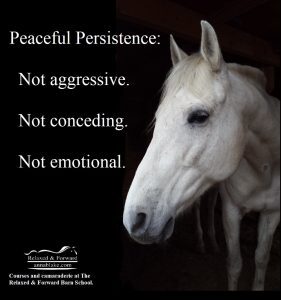Famous Cruelty, Ordinary Cruelty, and an Affirmative Solution

Another story of cruelty hit the international press last week. Operation X documented horrors happening in a well-known Danish barn, by using an undercover “groom” with a hidden camera. I won’t relate the gory details because you already know them. They are as nasty as you imagine. Repeating them feels like profanity. It was a dressage competitor this time, the riding discipline people love to hate. Also, the best foundation for any riding horse, so I will stand up, unwilling to surrender my beloved sport over to the haters. Want to know what real dressage is? Xenophon in 350 BC:
For what the horse does under compulsion, … is done without understanding; and there is no beauty in it either, any more than if one should whip and spur a dancer.
Please stop confusing dressage with cruelty. They are mutually exclusive. What happened at that barn was not dressage.
The story broke on the anniversary being roasted for an essay I wrote against (among other things) spade bits, comparing their use to the other kind of “grooming”. One comment I read about this latest cruelty compared this barn’s practices to priests abusing children. Good for her. Speak bluntly. Be as loud as abuse is damaging, but brace yourself for blowback. We love our traditions.
It’s only fair to mention other riding disciplines with systematic training methods used by a few cruel members. Like Western Pleasure, reining, gaited horses, rodeo, Big Lick Tennessee Walkers, the racing industry, etc, etc, etc. And doping happens in all of them. But why stop there? Include hoarders who masquerade as rescues and perpetrators of kill pen scams. Pinned ears on liberty horses and dead-eyed lesson horses. Shut down over-used therapy horses, and the cruelty done by cute kids riding big horses in strong bits. Colt starting competitions where more emphasis is put on showmanship than horsemanship. We romanticize punitive training to the point of hero worship. Wake up!
A reminder: we abuse dogs, too, but they yelp and howl. Horses are silent, unless we see the blood. Horses need advocates to speak for them.
 Here’s the true epidemic: we start youngsters with fear-based methods that have been scientifically debunked for decades. Domination isn’t the rule of the herd, we had it all wrong. Why do we still think the horse with the most anxiety is the “alpha”? We evolved our understanding of herd dynamics. This outdated method of waging war on babies is reprehensible. Even if the stoic ones will fake it for a while, a horse trained with fear will never be reliable. When do we open our eyes to change?
Here’s the true epidemic: we start youngsters with fear-based methods that have been scientifically debunked for decades. Domination isn’t the rule of the herd, we had it all wrong. Why do we still think the horse with the most anxiety is the “alpha”? We evolved our understanding of herd dynamics. This outdated method of waging war on babies is reprehensible. Even if the stoic ones will fake it for a while, a horse trained with fear will never be reliable. When do we open our eyes to change?
I swear, we have become so blind to cruelty, so normalized, that it’s like we have Stockholm syndrome (a bond between the abuser and the victim.) The defense most often stated by domination trainers was that their methods or painful tack are a time-honored tradition. We agree on that! Abusing horses is as old as Xenophon or we wouldn’t have that quote.
But wait! This is the extreme minority of horse owners.
Consistently being a bully is a sign of weakness, lack of education, inability to be flexible, and a void of creativity. How is it that a human tantrum passes as a training technique? Sure, we all have bad days when we get frustrated or rushed. The process of learning isn’t always smooth. In my work, I only see caring horse people who are trying to do better for their horses. Never monsters.
Cruelty makes for dramatic, attention-getting videos. Watching the slow gradual way that I train even bores my clients. If someone put an undercover spy in my barn, I’d find them snoring in the hay, sleeping off a hangover. But don’t assume I’m permissive, allowing horses to be dangerous, or that serious training isn’t happening. Working to rehab horses who got a rough start requires patience. We’re advancing the horse’s confidence as well as their ability. It’s not as easy as scaring them into submission.
Some say dressage, (or any other discipline,) is hard work that has to be trained harshly. As if any backyard horse can’t piaffe their way back to the barn. Separation anxiety isn’t dressage either. But instead of banning riding disciplines, let’s take them back. For all that we owe horses historically, and knowing more now, we can do better.
But if you want to complain, then you must also cheer the good guys. The monster in the Operation X video has been banned, the world is outraged. But the riders winning lately are training very differently. The British Dressage team posts photos of their elite horses in turnout with other horses as soon as they return home from international competitions (that they have just won.) Knowing how easily your rescue horse can hurt himself standing in your barn aisle, think of the commitment to welfare this alone takes. Could we at least give them a golf clap?
 Horse training is an art. It’s supposed to be hard. Using methods or training aids that make it faster or easier for us shouldn’t be the goal. Trust isn’t that cheap. We should stretch our skills and continue to learn. Take riding/training lessons from a good instructor. If they are harsh, walk away and find another. Attend clinics where your horse’s mental health is prioritized.
Horse training is an art. It’s supposed to be hard. Using methods or training aids that make it faster or easier for us shouldn’t be the goal. Trust isn’t that cheap. We should stretch our skills and continue to learn. Take riding/training lessons from a good instructor. If they are harsh, walk away and find another. Attend clinics where your horse’s mental health is prioritized.
Understanding equine calming signals is the biggest benefit to horses I know. We’ve been told to listen, but what do we listen for? Most of us are certain we understand equine body language, but sorry, horses would disagree.
Is that the problem? Have we seen their fear and pain for so long it looks normal to us?
Stop listening to the press. Stop courting the opinions of those who have never ridden, and those who train with intimidation. (It works as well on us as it does on horses.) We need to be open to change when we don’t like change. Spend silent time with the herd. But empty your mind first. Make your eyes brand new, make no excuses. Let all emotion go still. Give the horse space and air, rest your voice. When they feel safe, they will tell you in their bodies how they were trained and what they remember. We are not the judges of cruelty; they are.
It’s a good time to clean out the tack trunk. Make a pile of things that cause pain or the fear of confinement. Training “aids” like draw reins, tie-downs, and gadgets that restrain. Toss any but the most gentle snaffle bit. No more whips or weapons. Don’t sell them, so other horses suffer. Throw them out, and for once, be glad of waste.
If your horse gives you some resistance or needs some energy, then change your own energy to something brighter. Once and for all, commit to dive deep into the power of breathing as an affirmative cue. Be the change you want to see in your horse. If you don’t believe it will work, try it anyway. Let your horse change your mind. Will it take time? Yes, because horses expect the worst from us. Let’s disappoint them on that count.
Then speak up about how well your horse is doing. Pride isn’t the same as bragging and the mean minority is ruining it for the rest of us. Let people see that affirmative training methods work. Let your progress wear down the railbirds until they become impressed. It’s time to stop complaining on social media, amplifying the worst. Instead, speak up for kind training every chance you get. But for crying out loud, write letters to the FEI, USEF, NRHA and other equine governing bodies and let them know how you feel. They can’t ignore all of us.
Want the numbers? Women own over 90% of the horses. In total, that’s about two million American horse owners and over seven million people engaged in the industry as owners, service providers, employees, and volunteers. Most of us are forty-ish with a median income of $60k. We are the silent majority. Our voices can bring the haters to heel.
We claim we love horses and that should mean not just our own. When do we stop offering sad “thoughts and prayers” and get loud? When is it time to stop standing around clutching our bloody pearls? Who else do we think is going to fix this mess?
…
 Available Now! Undomesticated Women, Anectdotal Evidence from the Road, my new travel memoir. Ride along with us on a clinic tour through 30 states, 2 oceans, and 14k miles with me and my dog, Mister. It is an unapologetic celebration of sunsets, horses, RV parks, roadkill, diverse landscapes, and undomesticated women. Available now at Amazon, Barnes and Noble, and signed copies from me.
Available Now! Undomesticated Women, Anectdotal Evidence from the Road, my new travel memoir. Ride along with us on a clinic tour through 30 states, 2 oceans, and 14k miles with me and my dog, Mister. It is an unapologetic celebration of sunsets, horses, RV parks, roadkill, diverse landscapes, and undomesticated women. Available now at Amazon, Barnes and Noble, and signed copies from me.
…
If you or your horse appreciate what I write, please Subscribe to this blog or join us at The Barn School. To follow Bhim’s Training Diary, click here.

Want more? Become a “Barnie.” Subscribe to our online training group with affirmative demonstration videos, audio blogs, daily quotes, free participation in “group lessons”, and live chats with Anna. Become part of the most supportive group of like-minded horsepeople anywhere.
Anna teaches ongoing courses like Calming Signals and Affirmative Training at The Barn School, along with virtual clinics and our infamous Happy Hour. Everyone’s welcome.
Visit annablake.com to find archived blogs, purchase signed books, schedule a live consultation, subscribe for email delivery of this blog, or ask a question about the art and science of working with horses.
Affirmative training is the fine art of saying yes.
The post Famous Cruelty, Ordinary Cruelty, and an Affirmative Solution appeared first on Anna Blake.



